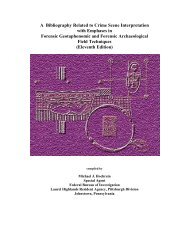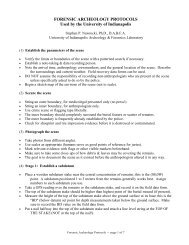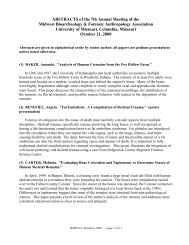Christopher W. Schmidt - University of Indianapolis Archeology ...
Christopher W. Schmidt - University of Indianapolis Archeology ...
Christopher W. Schmidt - University of Indianapolis Archeology ...
You also want an ePaper? Increase the reach of your titles
YUMPU automatically turns print PDFs into web optimized ePapers that Google loves.
Sample Population<br />
CHAPTER 3: MATERIALS AND METHODS<br />
Specimens were drawn from three collections in the United States and one collection in<br />
South Africa. The C.A. Hamann and T.W. Todd Osteological Collection at the Cleveland<br />
Museum <strong>of</strong> Natural History is comprised <strong>of</strong> skeletons from the late 19 th century and the early<br />
20 th centuries. These individuals were primarily unclaimed bodies from the Cuyahoga County<br />
Morgue and other hospitals in the Cleveland area. The Robert J. Terry Anatomical Skeletal<br />
Collection at the National Museum <strong>of</strong> Natural History in Washington D.C. is also composed <strong>of</strong><br />
skeletons from the late 19 th and early 20 th centuries. These were mostly unclaimed cadavers<br />
from St. Louis hospitals and institutional morgues, the majority <strong>of</strong> which came from lower socio-<br />
economic groups. The collection housed at the Forensic Research Laboratory at the <strong>University</strong><br />
<strong>of</strong> Florida is a known contemporary forensic collection. These jaws were sectioned and<br />
identified by a forensic odontologist and are currently being retained at the Forensic Research<br />
Laboratory as evidence. The Pretoria Bone Collection at the Department <strong>of</strong> Anatomy,<br />
<strong>University</strong> <strong>of</strong> Pretoria, South Africa is a modern cadaver collection from the mid-20 th century to<br />
the present. This collection is comprised <strong>of</strong> both donated and unclaimed cadavers.<br />
The Hamann-Todd and the Terry Collections were each visited for a one-week period.<br />
Data were colleted from the Pretoria Bone Collection over a two-month period. The Florida<br />
Collection was visited twice with a three-month intervening period for the purpose <strong>of</strong><br />
determining intra-observer error, which is discussed in the latter half <strong>of</strong> this chapter. The current<br />
study is limited to individuals <strong>of</strong> European and African ancestry. While the addition <strong>of</strong> Native<br />
Americans to the sample may have proven beneficial, I have decided to study only those<br />
individuals with a securely known sex and age at death. Since Native American skeletal<br />
33








